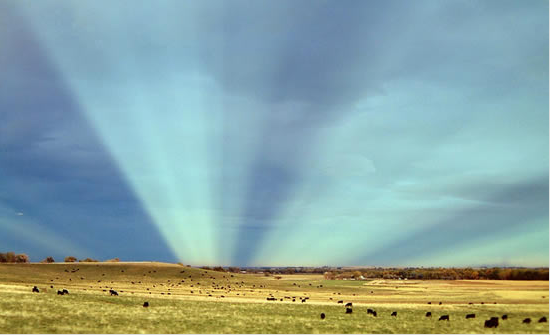Anti-crepuscular rays
Understanding Anti-Crepuscular Rays: Nature's Spectacular Illusion
Have you ever witnessed a mesmerizing display of rays converging away from the setting sun? These ethereal streaks of light, known as crepuscular rays, are a common atmospheric optical phenomenon. However, there is another captivating spectacle that occurs in the opposite direction, away from the rising sun - anti-crepuscular rays. In this article, we will delve into the fascinating world of anti-crepuscular rays, exploring their formation, characteristics, and the awe-inspiring scenes they create.
The Dance of Light
Anti-crepuscular rays, often referred to as anticrepuscular rays or antisolar rays, are an enchanting optical illusion that captivates observers. These radiant beams of light appear to converge towards a point opposite the sun, beneath the eastern horizon. Unlike crepuscular rays, which extend from the sun towards the observer, anti-crepuscular rays seemingly defy logic by appearing to originate from the antisolar point.
Unveiling the Illusion
The phenomenon of anti-crepuscular rays arises due to the interplay of sunlight and atmospheric particles. As sunlight passes through the Earth's atmosphere, it scatters off tiny particles such as dust, water droplets, or ice crystals suspended in the air. This scattering effect causes the light to disperse in different directions, resulting in the formation of both crepuscular and anti-crepuscular rays.
The Path Less Traveled
To witness anti-crepuscular rays, one must be in the right place at the right time. These elusive phenomena occur when the observer is positioned in an open area with an unobstructed view towards the eastern horizon during sunrise or shortly after. The conditions must align perfectly for the convergence of these rays to be visible to the naked eye.
The Science Behind the Illusion
The formation of anti-crepuscular rays is intricately linked to perspective. When the observer gazes towards the eastern horizon, they perceive the converging rays as if they were emanating from the antisolar point. This optical illusion is akin to the convergence of railroad tracks on the horizon, appearing to meet at a single point. However, in reality, the rays are parallel and only appear to converge due to the observer's perspective.
A Symphony of Colors
Similar to crepuscular rays, anti-crepuscular rays often exhibit a striking array of colors. These hues arise from the scattering and absorption of sunlight by atmospheric particles. As sunlight interacts with the particles, shorter wavelengths, such as blue and green, are scattered more readily, resulting in a reddish or golden appearance for the rays. The varying colors add an enchanting dimension to the already mesmerizing display.
The Artistry of Nature
The occurrence of anti-crepuscular rays provides nature with a canvas upon which it paints breathtaking scenes. Picture yourself standing in an open field during sunrise, witnessing these radiant beams stretching across the sky. As the sun bathes the landscape in warm hues, you may notice shadows cast by trees or structures seemingly converging towards the antisolar point. This surreal experience is a testament to the beauty and artistry of our natural world.
A Global Phenomenon
Anti-crepuscular rays are not confined to specific regions; they can be observed across the globe. However, their visibility may vary depending on atmospheric conditions and geographical location. To increase your chances of witnessing this awe-inspiring phenomenon, find a location with minimal light pollution and a clear view towards the eastern horizon during sunrise.
Capturing the Magic
Photographing anti-crepuscular rays can be a rewarding challenge for enthusiasts. To capture their full splendor, consider using a wide-angle lens to encompass the expansive sky. Experiment with different exposure settings to capture the vibrant colors and subtle details of these elusive rays. Patience and persistence are key, as the perfect shot may require multiple attempts and a keen eye for composition.
A Glimpse into the Extraordinary
Anti-crepuscular rays are a testament to the captivating wonders that can be found in the sky. These optical illusions remind us of the vastness and intricacy of our atmosphere. The next time you find yourself in the right place at the right time, take a moment to look towards the eastern horizon during sunrise. Who knows what extraordinary phenomenon might grace the sky and leave you in awe of nature's artistic prowess.

Surely crepuscular rays from an already set sun? But look at their milky colour and the cattle grazing in the sunlit landscape. These are extraordinarily bright anticrepuscular rays converging downwards away from the sun to the antisolar point beneath the eastern horizon.
The sun was shining low in the west when John Britton caught this scene from a moving car near Boulder, Colorado late afternoon October 11, 2001.
�John Britton, shown with permission.
Note: this article has been automatically converted from the old site and may not appear as intended. You can find the original article here.
Reference Atmospheric Optics
If you use any of the definitions, information, or data presented on Atmospheric Optics, please copy the link or reference below to properly credit us as the reference source. Thank you!
-
<a href="https://atoptics.co.uk/blog/anti-crepuscular-rays-2/">Anti-crepuscular rays</a>
-
"Anti-crepuscular rays". Atmospheric Optics. Accessed on April 25, 2024. https://atoptics.co.uk/blog/anti-crepuscular-rays-2/.
-
"Anti-crepuscular rays". Atmospheric Optics, https://atoptics.co.uk/blog/anti-crepuscular-rays-2/. Accessed 25 April, 2024
-
Anti-crepuscular rays. Atmospheric Optics. Retrieved from https://atoptics.co.uk/blog/anti-crepuscular-rays-2/.